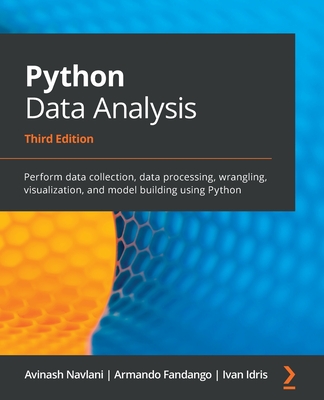Python: Data Analytics and Visualization
暫譯: Python:數據分析與視覺化
Phuong Vo.T.H, Martin Czygan, Ashish Kumar
- 出版商: Packt Publishing
- 出版日期: 2017-04-11
- 售價: $3,850
- 貴賓價: 9.5 折 $3,658
- 語言: 英文
- 頁數: 866
- 裝訂: Paperback
- ISBN: 1788290097
- ISBN-13: 9781788290098
-
相關分類:
Python、程式語言、Data Science
海外代購書籍(需單獨結帳)
買這商品的人也買了...
-
 Network Information Theory (Hardcover)
Network Information Theory (Hardcover)$1,460$1,431 -
 RNA-seq Data Analysis: A Practical Approach (Hardcover)
RNA-seq Data Analysis: A Practical Approach (Hardcover)$2,980$2,831 -
 Statistical Analysis of Next Generation Sequencing Data (Hardcover)
Statistical Analysis of Next Generation Sequencing Data (Hardcover)$6,400$6,080 -
 $1,686Statistical Analysis of Network Data with R (Use R!) 2014th Editio
$1,686Statistical Analysis of Network Data with R (Use R!) 2014th Editio -
 Next-Generation Sequencing Data Analysis (Hardcover)
Next-Generation Sequencing Data Analysis (Hardcover)$4,270$4,057 -
 Systems Biology of Cancer (Hardcover)
Systems Biology of Cancer (Hardcover)$4,100$3,895 -
 $960R Deep Learning Essentials (Paperback)
$960R Deep Learning Essentials (Paperback) -
 Quantum Biological Information Theory (Hardcover)
Quantum Biological Information Theory (Hardcover)$2,420$2,299 -
 Next Generation Sequencing: Translation to Clinical Diagnostics (Paperback)
Next Generation Sequencing: Translation to Clinical Diagnostics (Paperback)$11,970$11,372 -
 Computational Methods for Next Generation Sequencing Data Analysis (Hardcover)
Computational Methods for Next Generation Sequencing Data Analysis (Hardcover)$4,650$4,418 -
 $798Deep Learning with Hadoop (Paperback)
$798Deep Learning with Hadoop (Paperback) -
 $3,383Translational Bioinformatics and Systems Biology Methods for Personalized Medicine (Paperback)
$3,383Translational Bioinformatics and Systems Biology Methods for Personalized Medicine (Paperback)
商品描述
商品描述(中文翻譯)
理解、評估和視覺化數據
關於本書
- 學習數據分析的基本步驟以及如何使用 Python 及其套件
- 一步一步的預測建模指南,包括提示、技巧和最佳實踐
- 有效地視覺化廣泛的分析數據並生成有效的結果
本書適合對象
本書適合希望進入數據分析領域並希望以更高效和更具洞察力的方式視覺化其分析數據的 Python 開發者。
您將學到的內容
- 熟悉 NumPy,並在數據分析中使用陣列和陣列導向計算
- 使用 Pandas 的時間序列功能處理和分析數據
- 理解預測分析算法背後的統計和數學概念
- 使用 Matplotlib 進行數據視覺化
- 使用 NumPy、Scipy 和 MKL 函數進行互動式繪圖
- 使用蒙地卡羅模擬建立金融模型
- 創建有向圖和多重圖
- 使用 D3 進行高級視覺化
詳細內容
您將從數據分析原則及其支持的庫的介紹開始課程,並學習 NumPy 的基本知識以進行統計和數據處理。接下來,您將概述 Pandas 套件,並利用其強大的功能解決數據處理問題。然後,您將簡要了解 Matplotlib API。接下來,您將學習如何操作時間和數據結構,並使用 Python 套件在文件或數據庫中加載和存儲數據。您將學習如何使用 Python 中的強大套件將原始數據處理成純淨且有用的數據,並通過範例進行實踐。您還將簡要了解機器學習算法,即將數據分析結果應用於決策或構建有用的產品,如推薦和預測,使用 Scikit-learn。之後,您將進入數據分析專業化——預測分析。社交媒體和物聯網導致了數據的激增。您將開始使用 Python 進行預測分析。您將看到如何從數據創建預測模型。您將獲得有關統計和數學概念的平衡信息,並使用 Pandas、scikit-learn 和 NumPy 等庫在 Python 中實現它們。您將深入了解最佳的預測建模算法,如線性回歸、決策樹和邏輯回歸。最後,您將掌握預測建模的最佳實踐。之後,您將獲得所有實用的指導,幫助您在有效數據視覺化的旅程中前進。從一章關於數據框架的內容開始,該章解釋了數據轉化為信息,最終轉化為知識的過程,接下來的內容將涵蓋使用最流行的 Python 庫進行完整的視覺化過程,並提供實作範例。
這條學習路徑結合了 Packt 提供的一些最佳內容,形成一個完整的策劃包。它包括以下 Packt 產品的內容:
- 《Getting Started with Python Data Analysis》,Phuong Vo.T.H & Martin Czygan
- 《Learning Predictive Analytics with Python》,Ashish Kumar
- 《Mastering Python Data Visualization》,Kirthi Raman
風格與方法
本課程作為一步一步的指南,幫助您熟悉數據分析及其支持的 Python 庫,並通過真實世界的範例和數據集進行學習。它還幫助您通過在公共數據集上實施預測分析算法,獲得有關預測建模的實用見解。課程提供了豐富的實用指導,幫助您在數據視覺化的旅程中前進。






























